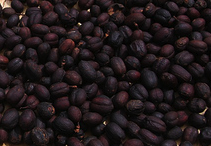
As many of our locals know, before we came to Auburn, we were missionaries living in Central and South America. I worked as a bush pilot with Mission Aviation Fellowship where I supported the work of missionaries to some degree, but to a greater degree my flying was in support of the indigenous tribes that inhabited the eastern rainforested jungles of Ecuador. The tribes includes the Waorani, Shuar, Atshuar and Quichua Indians.
In the northern Ecuadorian jungle lived several communities of Quichuas (the descendants of the Incas) who grew Arabica coffee. In one community, Arajuno (ah-dah-hun-no), each year they began picking the coffee in November and the picking lasted through the holidays and finished in January.
They processed their coffee the best they could easily in the jungle by laying out plastic sheets on the main street of their community and situating the picked beans onto the black plastic in the sun. As it baked in the sun and they raked it back and forth throughout the day, the outer layer (pulp) would split, dry out the four layers surrounding the coffee bean and pull away from the inner fruit which is the coffee bean. This is an example of dry processing.
Dry Processing
The dry-process is often used in countries where rainfall is scarce and long periods of sunshine are available to dry the coffee properly. Most coffees from Indonesia, Ethiopia, Brazil, and Yemen are dry-processed.

The entire cherry ( the red fruit of the coffee plant ) after harvest is placed in the sun to dry on tables, in thin layers on patios or in the case I witnessed in Ecuador, a plastic covered street. It will take between ten days and two weeks for the cherries to completely dry. The cherries need to be raked regularly to prevent mildew while they dry.
Once the skin of the cherry is dry, the pulp and parchment are removed by a hulling process. This is commonly done by sending the dried cherries off to a mill with machinery to do the hulling. There also, the sorting and grading occur. While coffee was once all dry processed it is now limited to regions where water or infrastructure for machinery is scarce.
My experience in Ecuador was unique in that this was the rain forest, but somehow they managed to get the coffee dried out enough. When I picked it up, I can remember looking at the dried knurly beans and what I was seeing was the actual bean still encased in the dried out pulp.
Characteristics of Dry Processed Coffee
The dry-process produces coffee that is heavy in body, sweet, smooth, and complex. They are also lower in acidity (not pH), a flavor characteristic some call “brightness” or other refer to as the dry characteristics of a good red wine.
Probably the best example of a dry processed coffee we have in our inventory would be our Sumatra. Of course there are slight variations on the dry process and my experience has been that Sumatra while often a dry processes can have a slight mildewy taint. That’s not a negative but an actual characteristic common to many Sumatrans.
__________________________
In our next article, we will talk about the more common processing method known as wet processing.
__________________________

Sandy Toomer is Roast Master and part owner of Toomer’s Coffee Roasters, a premium specialty coffee roaster located in Auburn, Alabama.